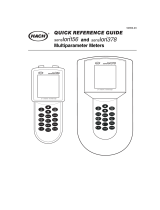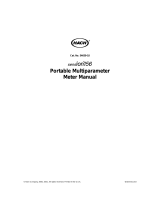Page is loading ...

Cat. No. 51910-88
PLATINUM SERIES
pH ELECTRODE
© Hach Company, 1999-2002. All rights reserved. Printed in China te/dk 02/05 2ed

2

3
Table of Contents
Specifications..................................................................................5
Safety Precautions..........................................................................7
Section 1 Introduction..............................................................9
1.1 Electrode Description..................................................................9
1.2 Electrolyte Description.............................................................10
1.3 Preparing the Electrode for Use..............................................10
1.3.1 Assembling the Electrode..............................................10
1.3.2 Conditioning the Electrode ...........................................12
1.4 Measuring Hints........................................................................13
1.5 Checking the Slope...................................................................14
1.6 Accessories.................................................................................14
1.6.1 Hach Low Ionic Strength Sample Chamber Kits........14
1.6.2 Sample Bottles................................................................15
1.7 General Applications................................................................15
Section 2 Applications ..........................................................17
pH, Water and Wastewater.............................................................19
pH, High Purity Water ....................................................................27
pH, Low Ionic Strength (LIS) Water..............................................35
Section 3 Electrode Maintenance........................................43
3.1 Storing the Electrode................................................................43
3.2 Cleaning the Electrode .............................................................44
Section 4 Platinum Series pH Electrode Characteristics.
47
4.1 Theory of Operation..................................................................47
4.2 Sodium Error Interferences......................................................48
Section 5 Troubleshooting.....................................................49
Electrode Service Request Questionnaire..................................53
Glossary.........................................................................................55
General Information................................................................59
How To Order................................................................................61
Repair Service...............................................................................62
Warranty........................................................................................63

4

5
Specifications
Specifications are subject to change without notice.
Electrode Type
pH combination with temperature probe
Range
0-14 pH units
Isopotential Point
7.00 ±0.5 pH units (0 ±29 mV)
Electrode Resistance
less than 100 Mohms at 25 °C (new)
Slope
-58 ±3 mV at 25 °C
Temperature Range
Routine Use – 0 to 45 °C (32 to 113 °F)
Occasional Use – 0 to 100 °C (32 to 212 °F)
Storage
-40 to 50 °C (-40 to 122 °F)
Reference Half Cell
Ag/AgCl/2.2 M KCl in 40% glycerol gel
Dimensions
Tip Diameter–12.3 mm (0.485 inches)
Tip Length–116 mm (4.55 inches)
Total Length–241 mm (9.5 inches)
Cable Length–0.91 m (36 inches)
Cable Connector
• sension 5-Pin Connector (Cat. No. 51910-00)
• Hach One™ Meter Series BNC & 3.5 mm Phone Connector
(Cat. No. 51910-11)
• EC Series BNC & DIN Connector (Cat. No. 51910-22)
Fill Solution
KCl Cartridges, Reference Gel (Cat. No. 25469-00)

6

7
Safety Precautions
Please read this entire manual before unpacking, setting up, or
operating this instrument. Pay particular attention to all danger
and caution statements. Failure to do so could result in serious
injury to the operator or damage to the equipment.
To ensure the protection provided by this equipment is not
impaired, do not use or install this equipment in any manner
other than that which is specified in this manual.
Use of Hazard Information
If multiple hazards exist, this manual will use the signal word
(Danger, Caution, Note) corresponding to the greatest hazard.
DANGER
Indicates a potentially or imminently hazardous situation
which, if not avoided, could result in death or serious injury.
CAUTION
Indicates a potentially hazardous situation that may result in
minor or moderate injury.
NOTE
Information that requires special emphasis.
Precautionary Labels
Read all labels and tags attached to the instrument. Personal
injury or damage to the instrument could occur if not observed.
This symbol, if noted on the instrument, references the
instruction manual for operational and/or safety information.

8

9
Section 1 Introduction
1.1 Electrode Description
The sension
™
Platinum Series pH Electrode (Figure 1) with a
renewable, free flowing reference junction is a reliable
electrode specifically designed for fast, accurate pH
measurement.
Figure 1
sens
ion
™
Platinum Series pH Electrodes
Platinum Series pH
Electrode with
Temperature Probe
(for use with
sens
ion pH meters)
(Cat. No. 51910-00)
Platinum Series pH
Electrode with
Temperature Probe,
BNC, & 3.5 mm
Connector
(for use with Hach
One™ Series pH
meters)
(Cat. No. 51910-11)
Platinum Series pH
Electrode with
Temperature Probe,
BNC & DIN
Connector (for use
with EC series pH
meters)
(Cat. No. 51910-22)

10
Introduction, continued
The Platinum Series pH Electrode uses a silver/silver chloride
reference element with a free-flowing junction. When the
dispenser button is pressed, electrolyte gel is dispensed past the
reference element to the reference junction.
The Platinum Series pH Electrode, Model 51910, uses a full
range pH glass that balances speed of response, full range, and
longevity. It is suitable for a wide variety of samples, including
hard-to-measure, pure water samples. If using the sens
ion
System, the meter will automatically account for buffer
temperatures during calibration. The Auto Buffer
Recognition/Auto Temperature Compensation calibration
program built into sens
ion meters contains accurate pH
profiles for buffers of pH 4.01, 6.86, 7.00, and 10.0 at
temperatures from 0 to 60 °C.
1.2 Electrolyte Description
In a conventional electrode, a frit restricts the release of
electrolyte into the sample. In the Platinum Series electrodes,
the medium viscosity electrolyte gel acts as a restriction device.
Fresh reference electrolyte is supplied from a replaceable
cartridge inside the electrode body by depressing the dispenser
button. By refreshing the electrolyte at the reference junction,
the Hach’s free-flowing reference system eliminates junction
potential errors caused by clogged frits. The gelling agent is
non-ionic and does not interfere with the free flow of ions
across the reference junction. Proper use and care of the
reference half cell extends its life.
1.3 Preparing the Electrode for Use
1.3.1 Assembling the Electrode
New electrodes are shipped with a soaker bottle to keep the
glass bulb hydrated. Remove the electrode from the soaker
bottle and prepare the electrode as follows:
1. Remove the cap from the electrolyte cartridge. Align the
fins on the cartridge with the grooves on the electrode
body. Press the cartridge firmly into the inlet tube of the

11
Introduction, continued
electrode body and rotate the cartridge clockwise until it is
seated (Figure 2).
2. Place the dispenser unit over the electrolyte cartridge.
Screw the dispenser unit onto the electrode body until it
stops turning. Do not over tighten.
Figure 2 Assembling the Platinum Series Electrode
Note:
The electrode will be automatically primed by screwing the dispenser unit
onto the electrode body.
3. If electrolyte gel is not visible at the reference outlet,
depress the pump button until it clicks; release the button.
Repeat this procedure until gel is visible at the reference
outlet. Alternatively, fully depress the button and rotate it
clockwise until gel is visible at the reference outlet (1 to 3
rotations).

12
Introduction, continued
4. Rinse the electrode with deionized water and blot dry with
a paper towel. Do not scrub the bulb.
5. To remove an empty cartridge, unscrew the dispenser unit
and rotate the cartridge counterclockwise while gently
pulling it out of the electrode.
1.3.2 Conditioning the Electrode
When a pH bulb is immersed in an aqueous solution, a hydrated
layer slowly forms at the glass/liquid interface. The formation
characteristics of this layer depend upon the type of glass, the
age of the glass, the previous usage history of the glass, the
temperature and ionic strength of the aqueous solution, etc.
This hydrated layer affects the sensing properties of the bulb
(charge transfer, and ion transport). A dry bulb will simply not
function.
To ensure the full development of the hydrated layer, electrodes
should be conditioned for several minutes in a solution
comparable to the sample in terms of pH and ionic strength.
Some samples may require special conditioning. See specific
applications for details.
1.3.2.1 Normal Conditioning
(For routine measurements in samples of moderate
to high conductivity, approximately 150 µS and
greater):
Initial use: During shipping, the electrode is kept hydrated by
a soaker bottle containing electrode solution. Remove the
bottle by loosening the cap. Save the bottle for reuse.
Between uses: Between sample measurements of medium to
high conductivity, store the electrode in Hach electrode storage
solution, a pH 6.35/1.7 M KCl buffer solution. The solution
keeps the bulb hydrated and prevents the reference gel from
solidifying in the reference junction. Hach electrode storage
solution is available in powder pillow form for dilution with
deionized water or as a prepared solution. The reusable soaker
bottle is convenient for field or laboratory use.

13
Introduction, continued
1.3.2.2 Low Ionic Strength (LIS) Conditioning
(For measurements in samples of low ionic
strength, approximately 150 µS/cm or less):
Initial use: Before measuring a LIS sample, pre-soak the
electrode in a solution similar to the sample in ionic strength
and pH for 10 to 15 minutes. Remove the electrode from this
solution and click the reference electrolyte dispenser until gel
emerges from the tip. Rinse the electrode with deionized water
from a wash bottle. Blot excess liquid with a soft paper towel.
Place the electrode in the sample.
Between uses: Between uses, in intervals of up to a few hours,
the electrode can be stored in the sample (if not an extreme pH),
or in a neutral LIS solution such as tap water. Before measuring
a new sample, refresh the reference electrolyte gel by clicking
the dispenser until fresh gel emerges and carefully rinse the
electrode to prevent sample contamination.
1.4 Measuring Hints
These suggestions will improve the accuracy of your
calibration and sample measurement.
• Dispense electrolyte if reading becomes unstable, erratic, or
if stabilization takes too long. An unstable reading may
also indicate an air bubble in the reference line. Remove the
electrode from the sample and invert it to view the
reference junction. Depress the dispenser button repeatedly
until the bubble is expelled (5 to 10 clicks should be
sufficient). Rinse with sample and blot to dry. Immerse the
electrode in the sample.
• Allow the potential to stabilize completely
(<1 mV/minute drift) before accepting a calibration point
or sample reading. Meters set to higher resolutions will take
longer to stabilize than meters set to lower resolutions.
• Use calibration standards and samples that are at the same
temperature to improve accuracy.
• Use fresh calibration standards to achieve greater accuracy.

14
Introduction, continued
• Thoroughly rinse and blot the electrode dry between
sample measurements. Remove the bulb guard before
measuring low ionic strength samples to prevent
transferring contaminants to the next sample, or rinse with
small volumes of sample.
• Analyze samples shortly after collecting them. Weakly
buffered alkaline solutions can absorb carbon dioxide
causing downward drift of pH readings. Cover samples if
necessary. When measuring LIS samples requiring high
levels of accuracy, use the LIS accessory sample chamber.
• A multi-point calibration will ensure more accurate
measurements than a single point calibration.
1.5 Checking the Slope
After calibrating the electrode with fresh buffer, check the slope
using the sens
ion meter’s calibration review option. A slope of
-58 ±3 mV indicates a properly functioning electrode.
1.6 Accessories
1.6.1 Hach Low Ionic Strength Sample Chamber Kits
The Hach Low Ionic Strength Sample Chamber Kit
(Cat. No. 51899-00) prevents sample contamination by carbon
dioxide. When a sample absorbs carbon dioxide from the
atmosphere, carbonic acid forms and the pH of the sample
decreases.
The kit includes a sample chamber with a cap suitable for:
• Measuring the pH of a grab sample while reducing the
sample’s exposure to the atmosphere.
• Measuring the pH of a flow or plug-flow sample with no
exposure to the atmosphere.

15
Introduction, continued
1.6.2 Sample Bottles
Sample bottles designed for use with or without the Low Ionic
Strength Sample Chamber are available in two grades
of cleanliness:
• General purpose bottles suitable for most drinking water
and wastewater tests.
• Bottles cleaned and certified according to EPA
specifications that are suitable for EPA reporting and for
testing
ultrapure water.
1.7 General Applications
SECTION 2 describes specific applications for the Platinum
Series pH Electrode. General applications include:
• Monitoring the pH of low ionic strength liquids such as
boiler, feedwater, and condensate.
• Environmental and ecological studies of natural waters
such as lakes, rivers, precipitation, and streams.
• Water and wastewater treatment to monitor influent and
effluent quality.
• Agricultural applications including soil, fertilizer, food,
and feed.
• Chemical and biological research.
• Industrial processes in the manufacture of foods,
beverages, pharmaceuticals, dyes, photographic film,
plating,
and chemicals.
• Continuous sampling in aqueous samples up to 45 °C and
intermittent sampling in aqueous samples up to 100 °C.
For information regarding applications not described in this
manual, contact Hach Technical and Customer Service.

16

17
Section 2 Applications

18

19
pH, Water and Wastewater (above 150 µS/cm)
1.Install the
Potassium Chloride
Electrolyte Gel
Cartridge in the
Platinum Series pH
Electrode. (See
Section
1.3.1
on page
10
for
assembly instructions.)
Note: This procedure
contains instructions for
the sens
ion™2.
However, any Hach
sens
ion
meter may be
used for this analysis.
2.Prime the electrode
by pushing the
dispenser button until
gel comes out of the
reference junction.
Rinse excess gel from
the tip and the outlet.
3.Connect the
electrode to the
sens
ion
2
pH/ISE
meter.
Note: Ensure that the
electrode has been
conditioned according
to instructions in
Section 1.3.2 on
page 12.

20
pH, Water and Wastewater, continued
4.Turn on the meter
by pressing
I/O. Press
PH MV until the
display shows pH.
5.Press SETUP. Press
the up arrow three
times. Press
ENTER to
toggle to the number
of desired decimal
places, then
EXIT to
leave setup.
6.In three 50-mL
beakers or cups,
prepare buffers of 4.0,
7.0, and 10.0 pH.
Note: The sample pH
should fall within the
range of the calibration
buffers.
Note: pH 6.86 buffer
may be used instead of
pH 7.0. Autobuffer
recognition for either pH
6.86 or 7.0 is user
selectable in the
sens
ion
meter setup.
pH mV
setup
/












